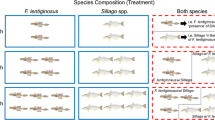Abstract.
Non-lethal effects of predators on prey behavior can mediate trophic cascades, but the extent of effects depends on habitat characteristics and risk sensitivity of prey. Furthermore, predation risk for stream organisms varies along the depth gradient and strongly influences their behavior. Grazing minnows (Campostoma anomalum) and crayfish (Orconectes virilis) are both prey for largemouth bass (Micropterus salmoides) in streams, but differ in their predator-avoidance behavior. This study contrasts the effects and mechanisms of non-lethal trophic cascades on the spatial distribution of filamentous green algae among stream pools and along a depth gradient within pools. Presence/absence of a largemouth bass was crossed with four combinations of the two grazer species (0 grazers, 30 minnows, 30 crayfish, and 15 each) in outdoor, experimental streams. Grazer densities were maintained by restocking. I used geostatistics to quantify spatial patterns of predator and grazer habitat use, height of filamentous algae in the water column, and spatial covariation of water depth with algal height, and depth with grazer habitat use. In streams with only minnows, bass were sedentary, and hid within tall algae in a single "bass pool". In pools with grazed algae, bass actively pursued prey within and among pools and used deeper water. This set up a hierarchy of risk to grazers along the depth gradient from bass in deep water to potential risk from terrestrial predators in shallow water. Thus, minnows were more sensitive than crayfish to predation risk from bass, but less sensitive than crayfish to risk from terrestrial predators. Minnows mediated cascades at the scale of whole pools by avoiding "bass pools", but only if crayfish were absent. Crayfish avoided potential interactions both with terrestrial predators and bass by grazing and burrowing in deeper water at night (when bass were inactive), and by hiding in burrows during daytime. Crayfish without burrows avoided bass and crayfish defending burrows by using shallow edges of pools as corridors, but did not graze there. Thus, crayfish-mediated cascades were limited to pool edges. Effects of grazer identity may extend to other consumers via modification of risk for biota that use filamentous algae as either foraging or refuge habitat.
Similar content being viewed by others
Author information
Authors and Affiliations
Additional information
Electronic Publication
Rights and permissions
About this article
Cite this article
Gelwick, F. Grazer identity changes the spatial distribution of cascading trophic effects in stream pools. Oecologia 125, 573–583 (2000). https://doi.org/10.1007/s004420000485
Received:
Accepted:
Published:
Issue Date:
DOI: https://doi.org/10.1007/s004420000485




